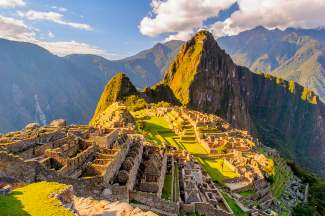
Visiting Peru’s magnificent Machu Picchu affords a unique opportunity to view the world as the Incas did from high up in the clear Andean Mountain air. From this vantage point, surrounded on all sides by dramatic snow-capped mountains, it is easy enough to agree with the ancient Incan belief system.
For the ancient Inca, sacred objects were less important that the awesome power of the natural wonders around them, and they imbued the objects on their horizon with both supernatural powers and the agencies to employ them. Rocks, rivers, lakes, and mountain peaks were all inhabited by
huacas or spirits.
The Inca also paid close attention to the sky for divine inspiration. To the Inca, the sun was a divine being, called Inti, and from his coupling with his sister Quilla the moon, came the first
Sapa Inca or supreme ruler of mankind. Though few representations of Inti remain today, we know from Spanish accounts in the 16th century that images of Inti were always made of gold, including his lavish temple at Cuzco, lined with over 700 sheets of beaten gold.
Inti’s yearly passage through the celestial sphere was of primary importance to the Inca. Using sophisticated geometric principles, they designed elaborate markers of stone to accurately calculate the dates of the solstices and equinoxes, essential points on the famous Inca calendar. These points regulated not only the spiritual life of the entire empire, but also the more humdrum but important yearly schedules for agriculture, herding, and rites of passage.
One extraordinary structure at Machu Picchu used to trace Inti remains partially intact. The Inti Watana or “hitching post of the sun” is just one of many such posts, sadly destroyed en masse by the Spanish. These large pillars or
gnomons are positioned to accurately pinpoint the key events of the astrological year. During the winter solstice (June 21), the gnomon casts a long shadow south. Conversely, during the summer solstice (December 21), the gnomon casts its shortest shadow to the northern side. On the autumnal and vernal equinoxes, at midday, the gnomon casts no shadow at all.
Each year during the Summer Solstice, the High Priest of the Inca would climb up to the gnomon to ritually “hitch” the sun to the earth, thereby ensuring that Inti would not escape, but begin his journey anew.
Learn more about the Inca and visit Machu Picchu on Alexander + Robert’s popular
Machu Picchu + the Galapagos Cruise, which includes a Complete Machu Picchu Experience as well as a deluxe cruise around the fascinating Galapagos Islands. Speak to one of our knowledgeable reservation agents to learn more.